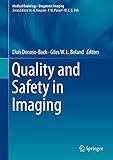Quality and safety in imaging / Lluís Donoso-Bach, Giles W.L. Boland, editors.
Material type: TextSeries: Medical radiology (Series)Publisher: Cham, Switzerland : Springer, 2018Description: 1 online resourceContent type:
TextSeries: Medical radiology (Series)Publisher: Cham, Switzerland : Springer, 2018Description: 1 online resourceContent type: - text
- computer
- online resource
- 9783319425788
- 3319425781
- 9783319425771
- 3319425773
- 616.07/54 23
- RC78.7.D53
| Item type | Current library | Shelving location | Call number | Status | Date due | Barcode | Item holds | |
|---|---|---|---|---|---|---|---|---|
 Electronic Book
Electronic Book
|
Kuakarun Nursing Library | Processing unit | Online Access | Eb35490 |
This book provides a roadmap for optimizing quality and safety within radiology practices, whether academic or private and irrespective of their national setting. All aspects of the radiology workflow are addressed, from imaging appropriateness, examination scheduling, and patient preparation through to imaging protocol optimization (including radiation dose management), modality operations, reporting (including structured reporting), and report communication. The book highlights innovative IT tools, including clinical decision support, that drive compliance with national best practice standards and guidelines. The use of big data tools to manage and enhance clinical delivery is addressed. Finally, metrics designed to measure the value that radiology brings to patient care and patient outcomes are introduced. Readers wishing to deepen their understanding of contemporary best practices regarding quality and safety will find this book to be a rich source of practical information.
Includes index.
Online resource; title from PDF title page (SpringerLink, viewed September 26, 2018).
Intro; Contents; Contributors; Part I: Introduction; Framing the Issues; Part II: Imaging Appropriateness; Guideline Development; References; Clinical Decision Support Tools for Order Entry; 1 Definitions; 2 Trends in Imaging Use and Costs; 3 General Features of Effective Clinical Decision Support During Radiology Order Entry; 4 Effectiveness of Clinical Decision Support in Radiology; 5 Experience from Large Scale Implementation of Imaging CDS; 6 Emerging Challenges and Opportunities for Imaging Clinical Decision Support; 7 Future Direction; References; Part III: Imaging Protocols.
Informed Use of Medical Radiation in Diagnostic Imaging1 Introduction; 2 The Association of Safety and Quality for Medical Radiation; 3 Factors Contributing to the Current Profile for Radiation (and Risk) in Medical Imaging; 4 Radiation and Risk; 5 Strategies for Safe Use of Ionizing Radiation in Medical Imaging; 6 Radiation Risk Dialogues; References; Approach to CT Dose Optimization: Role of Registries and Benchmarking; 1 Factors Affecting CT Radiation Doses; 2 CT Dose Descriptors; 3 ACR DIR and European Guidelines; 4 Scenarios for CT Dose Optimization; 5 Summary; References.
Part IV: Modality OperationsClinical Audit; 1 Definition of Clinical Audit; 2 The Purpose and Role of Audit; 3 Models of Audit; 4 Internal vs. External Audit; 5 Scope of Clinical Audit; 5.1 Structure; 5.2 Process; 5.3 Outcome; 6 Source of Target Standards; 7 Ownership and Accuracy of Audit Data; 8 Education and Training; References; Quality Metrics: Definition, Creation, Presentation, and Use; 1 Overview; 2 What Is Quality?; 3 Why Measure Quality?; 4 Characteristics of Good Quality Metrics; 5 Examples of Imaging Quality Metrics; 5.1 Safety; 5.2 Timeliness; 5.3 Effectiveness.
5.4 Patient Centered6 Creation, Presentation, and Distribution of Quality Metrics; 7 Managing Change; References; Part V: Reporting; Reporting: Recommendations/Guidelines; 1 Scope of the Problem; 2 Guidelines for Incidental Findings; 3 Inconsistencies in Managing Incidental Findings; 4 Guidelines for Other Conditions; 5 Medicolegal Implications of Using Guidelines; 6 Costs Associated with Managing Incidental Findings; 7 Processes for Developing Guidelines; 8 Nature and Form of Guidelines; 9 Integrating Guidelines into Reports; References.
Structured Reporting: The Value Concept for Radiologists1 Introduction; 2 Definition of Structured Reporting; 3 Constrained Vocabularies, Lexicons, and Common Data Elements; 4 Legislative Framework Promoting Structured Reporting; 5 Development of Report Templates as a Team; 6 The Value Proposition of Structured Reporting; 7 Limitations and Concerns; References; Clinical Decision Support at the Radiologist Point of Care; 1 Introduction; 2 Addressing the Challenge of Report Variability; 3 Cracking the Code of Interpretive Variability; 4 The Open CAR/DS Framework.
Master record variable field(s) change: 650
There are no comments on this title.

